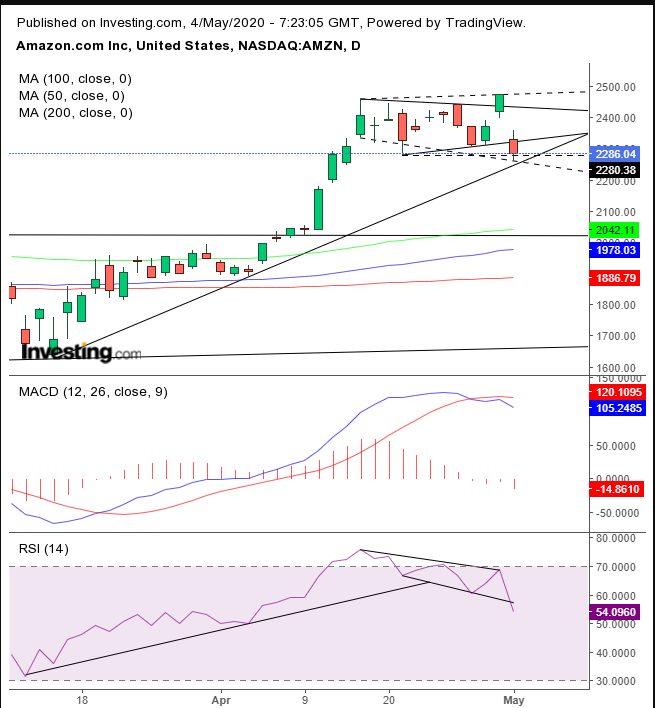On Thursday, during the company's earnings call, Amazon (NASDAQ:AMZN) founder and CEO Jeff Bezos told shareholders to “take a seat” as he warned of the e-tailer's first quarterly loss in five years. In response, post-results, investors sent their own message to Bezos: they erased $83 billion from the company's valuation by selling off shares.
Though the Seattle-based internet giant saw sales jump 26% YoY, in part because of COVID-19 lockdowns moving retail consumption to online sites since stores and malls were closed because of fears of viral spreading, the company also announced that it will be spending more than $4 billion in operating profits through June to protect employees from the coronavirus, thus the losses.
For the cynical, this can be characterized is a brilliant PR move in which the giant tech company hopes to save face, after, on April 24 an appeal against an earlier lawsuit in the French court system—in which employees claimed the Amazon hadn't done enough to keep them safe as they worked—came back in favor of the employees. Among other things, the decision called for Amazon to stop delivering nonessential items in France.
On the other hand, we're impressed by the move, not only because it is moral, but because it also provides for economic endurance. While other companies have been firing or furloughing employees—to the tune of more than 30 million workers in the US—Amazon actually went on a hiring spree, adding a breathtaking 175,000 workers. This seemingly counterintuitive move was made to enable the company to keep up with the added demand from customers sheltering at home and unable to peruse brick-and-mortar outlets.
We believe some investors either didn’t see the big picture or simply lost patience with the stock. Shares of Amazon were down 7.6% as of Friday's close.
In our view, the stock could now continue to head lower. We don’t yet know how much President Donald Trump’s renewed tariff rhetoric has affected the overall market outlook, or how successful the company has been at moving manufacturing out of China since last year’s trade war. For now, we’re looking at the short-to-medium term, based on the technicals.

Friday’s selloff established one of two things, either:
(1) The failure of pennant, a continuation pattern (along the solid lines) and therefore bullish after the April surge. This already completed itself Thursday, with an upside breakout, demonstrating that demand had absorbed all available supply within the pattern and was now upping bids to find new, willing sellers at higher prices.
or
(2) The beginning of a Broadening Pattern (along the dotted lines), which is bearish since it develops amid emotional trading, lacking in market leadership.
Either way, a failed bullish pattern or a reversal pattern, both end up being bearish.
The one difference is that in the first scenario, the downside breakout already occurred, while in the second it's still forming. Also, the uptrend line since the March bottom remains a support, although both the RSI and MACD have turned around from peaks, suggesting prices will fall through the uptrend line.
Does this analysis jibe with the one we posted on April 22, when we discussed a seven-and-half month ascending triangle, a bullish pattern? Actually, it fits perfectly.
In that post our analysis suggested the stock would ultimately go higher, but that bulls wait for a better entry. That could be about to materialize.
The current reversal is the makeup for a return move to the $2,000 level, to retest that bullish pattern. Unless the market dynamic changes in the interim—and we don’t consider money spent to ensure continued service amid COVID-19 business carnage anything other than an investment that also boosts the company’s morale and efficacy—the $2,000 level should provide a solid support, allowing for another bounce.
Trading Strategies
Conservative traders would wait for a return to $2,000 and wait for accumulation as evidence that market structure remained intact.
Moderate traders may wait for the pullback, for that better entry but not necessarily for proof of trend.
Aggressive traders are likely to short the stock, providing they understand that if the current pattern is in fact a Broadening Formation, the stock can revisit its top, at $2,500, even if it would continue lower from there. To avoid being whipsawed, they might want to wait for a close below the uptrend line.
Trade Sample: Short Position
- Entry: $2,280
- Stop-Loss: $2,330
- Risk: $50
- Target: $2,080
- Reward: $200
- Risk:Reward Ratio: 1:4
